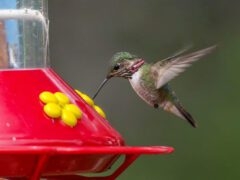Western Flycatcher Similar Species Comparison
Main SpeciesWestern Flycatcher
Small flycatcher with a peaked crown and teardrop-shaped eyering. Olive above and yellowish below, with two light wingbars.
© Liam Singh / Macaulay LibraryBritish Columbia, April 28, 2020Small flycatcher found in forested habitats. Olive overall, with individuals showing varying amounts of yellow below. Note peaked crown, teardrop-shaped eyering, and whitish wingbars. Bill is black above and orangish below.
© Max Nootbaar / Macaulay LibraryColorado, July 06, 2018Small flycatcher with a peaked crown, teardrop-shaped eyering, and two light wingbars. Olive above with varying amounts of yellow below. Flicks tail frequently (as do some other Western Empidonax flycatchers).
© Don DesJardin / Macaulay LibraryCalifornia, April 25, 2014Rare visitor to eastern North America, usually in late fall. The combination of yellowish underparts and teardrop-shaped eyering helps in differentiating from eastern Empidonax flycatchers.
© Jeremiah Trimble / Macaulay LibraryMassachusetts, November 25, 2020Small flycatcher with olive upperparts, two light wingbars, peaked crown, and teardrop-shaped eyering. Fairly broad bill is orangish below.
© Oliver Patrick / Macaulay LibraryArizona, July 12, 2018Nests on banks (as well as in trees, shrubs, and cavities, or on buildings and bridges). The female builds an elaborate cup nest, adding mosses and lichens to the outside of the nest.
© Larry Arbanas / Macaulay LibrarySonora, May 19, 2006Small, olive-backed flycatcher with teardrop-shaped eyering, peaked crown, and white wingbars.
© Robert Hamilton / Macaulay LibraryCalifornia, April 24, 2014Usually yellowish below, with darker wash across breast (but some individuals have very limited yellow).
© Mark Stephenson / Macaulay LibraryCalifornia, June 22, 2020Calls include a short "tsip" and a piercing "seet."
© Brian Sullivan / Macaulay LibraryCalifornia, June 25, 2022"Cordilleran" group breeds in dry evergreen and mixed forests in interior western North America, mainly along the Rocky Mountains and Mexico's Sierra Madre.
© Noreen Baker / Macaulay LibraryColorado, July 01, 2016"Pacific-slope" group breeds in humid evergreen forests, pine-oak forests, and dense second-growth woodlands.
© Ted Down / Macaulay LibraryBritish Columbia, August 02, 2016Similar SpeciesHammond's Flycatcher
The best way to differentiate Hammond's Flycatcher—and all Empidonax flycatchers—from Western Flycatcher is by voice. Hammond's Flycatcher is grayer than Western Flycatcher, with a rounded head and a small bill.
© Braxton Landsman / Macaulay LibraryCalifornia, April 09, 2023Similar SpeciesDusky Flycatcher
The best way to differentiate Dusky Flycatcher—and all Empidonax flycatchers—from Western Flycatcher is by voice. Dusky Flycatcher has a rounded head (as opposed to a peaked crown) and is grayer than Western Flycatcher.
© Steve Wickliffe / Macaulay LibraryMontana, June 07, 2022Similar SpeciesYellow-bellied Flycatcher
Yellow-bellied Flycatcher is very similar to Western Flycatcher, but their ranges do not overlap. On the rare occasion when a Yellow-bellied Flycatcher strays to the western U.S., its rounded head, circular eyering (lacking a teardrop), and higher-contrast wing pattern help distinguish it from Western Flycatcher.
© Anonymous / Macaulay LibraryCalifornia, October 06, 2022Similar SpeciesWestern Wood-Pewee
Western Wood-Pewee is larger than Western Flycatcher, with a darker head, a gray "vest," and no eyering.
© Frank Lin / Macaulay LibraryBritish Columbia, May 31, 2022Compare with Similar Species
Click on an image to compare
Species in This Family
Tyrant Flycatchers(Order: Passeriformes, Family: Tyrannidae)
Don't miss a thing! Join our email list
The Cornell Lab will send you updates about birds,
birding, and opportunities to help bird conservation.








































